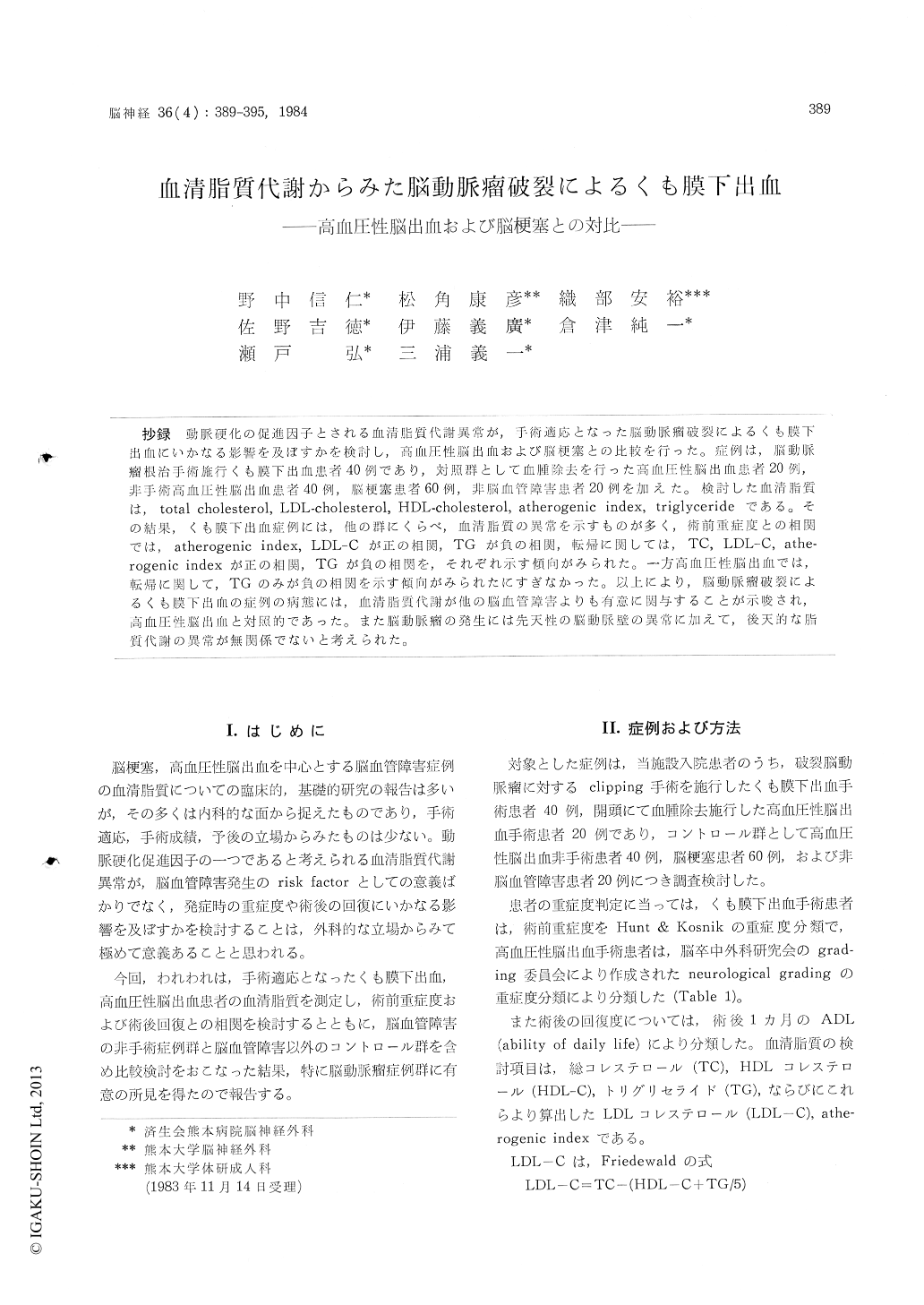Japanese
English
- 有料閲覧
- Abstract 文献概要
- 1ページ目 Look Inside
抄録 動脈硬化の促進因子とされる血清脂質代謝異常が,手術適応となった脳動脈瘤破裂によるくも膜下出血にいかなる影響を及ぼすかを検討し,高血圧性脳出血および脳梗塞との比較を行った。症例は,脳動脈瘤根治手術施行くも膜下出血患者40例であり,対照群として血腫除去を行った高血圧性脳出血患者20例,非手術高血圧性脳出血患者40例,脳梗塞患者60例,非脳血管障害患者20例を加えた。検討した血清脂質は,total cholesterol,LDL-cholesterol,HDL-cholesterol,atherogenic index,triglycerideである。その結果,くも膜下出血症例には,他の群にくらべ,血清脂質の異常を示すものが多く,術前重症度との相関では,atherogenic index,LDL-Cが正の相関,TGが負の相関,転帰に関しては,TC,LDL-C,athe—rogenic indexが正の相関,TGが負の相関を,それぞれ示す傾向がみられた。一方高血圧性脳出血では,転帰に関して,TGのみが負の相関を示す傾向がみられたにすぎなかった。以上により,脳動脈瘤破裂によるくも膜下出血の症例の病態には,血消脂質代謝が他の脳血管障害よりも有意に関与することが示唆され,高血圧性脳出血と対照的であった。また脳動脈瘤の発生には先天性の脳動脈壁の異常に加えて,後天的な脂質代謝の異常が無関係でないと考えられた。
Lipids metabolism has been extensively studied in the large number of patients with hypertensive cerebral hemorrhage or cerebral infarction, how-ever, the patients with subarachnoid hemorrhage due to ruptured intracranial aneurysm were custom-arily excluded from the study. Total cholesterol, LDL-cholesterol, HDL-cholesterol, triglyceride and atherogenic index were determined in 40 cases, who had undergone surgical treatment for ruptur-ed intracranial aneurysm in various locations, and the results were compared with the data obtained from 20 operative cases with hypertensive cerebral hemorrhage, 40 cases with non-operative cases with hypertensive cerebral hemorrhage, 60 cases with cerebral infarction and 20 cases of cerebral lesions other than cerebrovascular disease (non-CVA).
Serum levels of LDL-cholestcrol and atherogenic index were significantly correlated with the pre-operative grading of subarachnoid hemorrhage when compared with non-CVA (p<0.05). Total cholesterol, LDL-cholestrol and atherogenic index were well correlated with operative morbidity and active daily life (ADL) in the follow-up study of the patients with intracranial aneurysm, where the higher value of cholesterol indicated the poorer risk of the patients.
In our present study, none of the data was found significant, when compared with non-CVA, in the other groups of cerebrovascular diseases except for the HDL-cholesterol, which was found significantly in low level in the group of cerebral infarction (p<0.001). Triglyceride was found elevated in the group of hypertensive hemorrhage indicating ne-gative correlation to the severity, and rather simi-lar pattern was seen in the subarachnoid hemor-rhage, however, the data were not conclusive.
When subarachnoid hemorrhage being compared with other groups, the levels of total cholesterol, LDL-cholesterol, and atherogenic index were signi-ficantly in higher value, and HDL-cholesterol was in inverted relation. It was quite interesting to find more conspicuous disorder of the lipids meta-bolism in the group of subarachnoid hemorrhage, and it can be postulated that aneurysmal formation of the proximal cerebral arteries should be attri-buted partly to the acquired lesion due to meta-bolic change in lipids, beside congenital defect of the arterial wall.

Copyright © 1984, Igaku-Shoin Ltd. All rights reserved.


